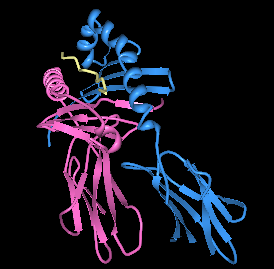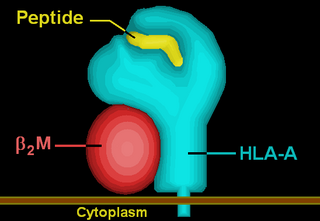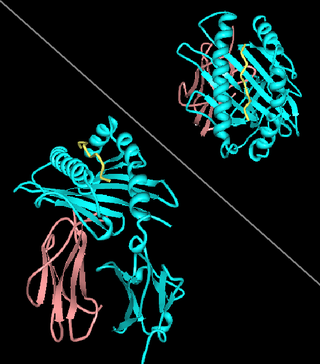HLA DR3-DQ2 is double serotype that specifically recognizes cells from individuals who carry a multigene HLA DR, DQ haplotype. Certain HLA DR and DQ genes have known involvement in autoimmune diseases. DR3-DQ2, a multigene haplotype, stands out in prominence because it is a factor in several prominent diseases, namely coeliac disease and juvenile diabetes. In coeliac disease, the DR3-DQ2 haplotype is associated with highest risk for disease in first degree relatives, highest risk is conferred by DQA1*0501:DQB1*0201 homozygotes and semihomozygotes of DQ2, and represents the overwhelming majority of risk. HLA DR3-DQ2 encodes DQ2.5cis isoform of HLA-DQ, this isoform is described frequently as 'the DQ2 isoform', but in actuality there are two major DQ2 isoform. The DQ2.5 isoform, however, is many times more frequently associated with autoimmune disease, and as a result to contribution of DQ2.2 is often ignored.

HLA-DQ8 (DQ8) is a human leukocyte antigen serotype within the HLA-DQ (DQ) serotype group. DQ8 is a split antigen of the DQ3 broad antigen. DQ8 is determined by the antibody recognition of β8 and this generally detects the gene product of DQB1*0302.
Immunogenetics or immungenetics is the branch of Medical Immunology and Medical Genetics that explores the relationship between the immune system and genetics.
Antonio Arnaiz-Villena is a Spanish immunologist noted for his controversial research into the genetic history of ethnic groups and fringe linguistic hypotheses.

The Journal of Immunology is a biweekly peer-reviewed medical journal that publishes basic and clinical studies in all aspects of immunology. Established in 1916, it changed its name to Journal of Immunology, Virus Research and Experimental Chemotherapy from 1943 to 1949, then returned to the original Journal of Immunology in 1950. It is the official journal of the American Association of Immunologists. The editor-in-chief is Eugene M. Oltz.

HLA-A69 (A69) is a human leukocyte antigen serotype within HLA-A serotype group. The serotype is determined by the antibody recognition of α69 subset of HLA-A α-chains. For A69, the alpha "A" chain are encoded by the HLA-A*69 allele group and the β-chain are encoded by B2M locus. This group currently is dominated by A*6901. A69 and A*69 are almost synonymous in meaning. A69 is a split antigen of the broad antigen serotype A28. A69 is a sister serotype of A68.

HLA-A24 (A24) is a human leukocyte antigen serotype within HLA-A serotype group. The serotype is determined by the antibody recognition of α24 subset of HLA-A α-chains. For A24, the alpha, "A", chain are encoded by the HLA-A*24 allele group and the β-chain are encoded by B2M locus. This group currently is dominated by A*2402. A24 and A*24 are almost synonymous in meaning. A24 is a split antigen of the broad antigen HLA-A9 and it is a sister serotype of HLA-A23.

MHC class I polypeptide–related sequence A (MICA) is a highly polymorphic cell surface glycoprotein encoded by the MICA gene located within MHC locus. MICA is related to MHC class I and it has similar domain structure, however, it is not associated with β2-microglobulin nor binds peptides as conventional MHC class I molecules do. MICA rather functions as a stress-induced ligand (as a danger signal) for integral membrane protein receptor NKG2D ("natural-killer group 2, member D"). MICA is broadly recognized by NK cells, γδ T cells, and CD8+ αβ T cells which carry NKG2D receptor on their cell surface and which are activated via this interaction.

Leukocyte immunoglobulin-like receptor subfamily B member 2 is a protein that in humans is encoded by the LILRB2 gene.

Leukocyte immunoglobulin-like receptor subfamily B member 4 is a protein that in humans is encoded by the LILRB4 gene.

HLA class II histocompatibility antigen, DQ(6) alpha chain is a protein that in humans is encoded by the HLA-DQA2 gene. Also known as HLA-DXA or DAAP-381D23.2, it is part of the human leucocyte antigen system.

Complement C4-A is a kind of the Complement component 4 protein that in humans is encoded by the C4A gene.

Leukocyte immunoglobulin-like receptor subfamily A member 3 (LILR-A3) also known as CD85 antigen-like family member E (CD85e), immunoglobulin-like transcript 6 (ILT-6), and leukocyte immunoglobulin-like receptor 4 (LIR-4) is a protein that in humans is encoded by the LILRA3 gene located within the leukocyte receptor complex on chromosome 19q13.4. Unlike many of its family, LILRA3 lacks a transmembrane domain. The function of LILRA3 is currently unknown; however, it is highly homologous to other LILR genes, and can bind human leukocyte antigen (HLA) class I. Therefore, if secreted, the LILRA3 might impair interactions of membrane-bound LILRs with their HLA ligands, thus modulating immune reactions and influencing susceptibility to disease.
HLA A1-B8 is a multigene haplotype that covers the MHC Class I region of the human major histocompatibility complex on chromosome 6. A multigene haplotype is set of inherited alleles covering several genes, or gene-alleles; common multigene haplotypes are generally the result of identity by descent from a common ancestor. Chromosomal recombination fragments multigene haplotypes as the distance to that ancestor increases in number of generations.
HLA B7-DR15-DQ6 is a multigene haplotype that covers a majority of the human major histocompatibility complex on chromosome 6. A multigene haplotype is set of inherited alleles covering several genes, or gene-alleles, common multigene haplotypes are generally the result of descent by common ancestry. Chromosomal recombination fragments multigene haplotypes as the distance to that ancestor increases in number of generations.
Dennis Bernard Amos was a British born American immunologist. National Academies Press called Amos "one of the most distinguished scientists of the genetics of individuality of the twentieth century". In 1969, Amos and Dr. David Hume founded the first regional organ sharing program in the United States. Amos made significant contributions in immunogenetics, tumor immunity, and transplantation immunology.

Narinder Kumar Mehra is an Indian immunologist, head of the department of transplant immunology and immunogenetics of the SRL Limited, Gurgaon. He is a former dean of research and holds the ICMR Dr. C.G. Pandit National Chair at AIIMS. An elected fellow of the International Medical Sciences Academy, The World Academy of Sciences, Indian National Science Academy and National Academy of Sciences, India, Mehra is known for his research on histocompatibility and immunogenetics. The Council of Scientific and Industrial Research, the apex agency of the Government of India for scientific research, awarded him the Shanti Swarup Bhatnagar Prize for Science and Technology, one of the highest Indian science awards for his contributions to Medical Sciences in 1992. He received the Chevalier of the National Order of Merit from François Mitterrand in 2003.
Frances Brodsky is an American cell biologist. She is known for her work on clathrin and its role in the function of the immune system. She is a professor of cell biology and the director of the Division of Biosciences at University College London. She is the author of three scientific mystery novels under the pseudonym B.B. Jordan. She was the founding editor of the journal Traffic.

The American Society for Histocompatibility and Immunogenetics is a scientific society that was established in 1972. It is responsible for accrediting HLA typing laboratories internationally to maintain the quality standards for histocompatibility testing between donors and recipients, with UNOS and NMDP utilizing its service to inspect and determine whether laboratories complied to industrial practices. They also published the first CWD allele list, encouraging researchers to compare genetic differences between populations. The society sponsors the American College of Histocompatibility and Immunogenetics, and offers 5 levels of certification. The medical journal Human Immunology is published by Elsevier on behalf of the society.

Kamala Balakrishnan was an Indian military officer and immunologist. She was a lieutenant colonel in the Indian Armed Forces, president of the American Society of Histocompatibility and Immunogenetics (ASHI), and director of the Transplantation Immunology Division at the Paul Hoxworth Blood Center in Cincinnati, Ohio.










